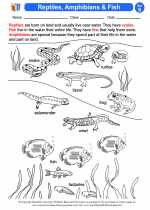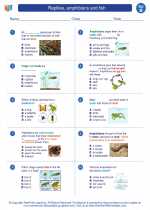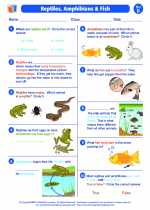Reptiles, amphibians and fish -> grasslands
Grasslands
Grasslands are vast areas characterized by grasses, herbs, and non-woody plants, with few trees. They are found on every continent except Antarctica and cover approximately 25% of the Earth's land surface. Grasslands are also known as prairies, steppes, or savannas, depending on their location and climate.
Characteristics of Grasslands:
- Grasses and non-woody plants are the dominant vegetation.
- They are generally flat with few hills or mountains.
- They experience seasonal droughts and occasional fires.
- They are home to a diverse range of wildlife, including grazing animals like bison, antelope, and zebras, as well as predators like lions and wolves.
Types of Grasslands:
There are two main types of grasslands:
- Temperate Grasslands: Found in regions with cold winters and hot summers, such as the Great Plains of North America and the steppes of Eurasia.
- Tropical Grasslands: Found in warm areas with distinct wet and dry seasons, such as the savannas of Africa and South America.
Importance of Grasslands:
Grasslands play a crucial role in the ecosystem and provide various benefits:
- They support a variety of plant and animal species.
- They serve as grazing areas for livestock and wildlife.
- They help maintain soil stability and prevent erosion.
- They store carbon and contribute to the global carbon cycle.
Study Guide:
Here are some key points to remember when studying grasslands:
- What are the dominant vegetation in grasslands?
- What are the two main types of grasslands and where are they found?
- What are the characteristics of grasslands?
- Why are grasslands important for the ecosystem?
Remember to also explore the specific flora and fauna found in different types of grasslands, as well as the human impact on these ecosystems.
[Grasslands] Related Worksheets and Study Guides:
.◂Science Worksheets and Study Guides Second Grade. Reptiles, amphibians and fish
Study Guide Reptiles, amphibians and fish
Reptiles, amphibians and fish  Activity Lesson
Activity Lesson Reptiles, Amphibians & Fish
Reptiles, Amphibians & Fish  Worksheet/Answer key
Worksheet/Answer key Reptiles, amphibians and fish
Reptiles, amphibians and fish  Worksheet/Answer key
Worksheet/Answer key Reptiles, amphibians and fish
Reptiles, amphibians and fish  Worksheet/Answer key
Worksheet/Answer key Reptiles, amphibians and fish
Reptiles, amphibians and fish  Worksheet/Answer key
Worksheet/Answer key Reptiles, Amphibians and Fish
Reptiles, Amphibians and Fish  Vocabulary/Answer key
Vocabulary/Answer key Reptiles, amphibians and fish
Reptiles, amphibians and fish 

 Activity Lesson
Activity Lesson
 Worksheet/Answer key
Worksheet/Answer key
 Worksheet/Answer key
Worksheet/Answer key
 Worksheet/Answer key
Worksheet/Answer key
 Worksheet/Answer key
Worksheet/Answer key
 Vocabulary/Answer key
Vocabulary/Answer key

The resources above cover the following skills:
LIFE SCIENCE (NGSS)
Ecosystems: Interactions, Energy, and Dynamics
Students who demonstrate understanding can:
Plan and conduct an investigation to determine if plants need sunlight and water to grow.